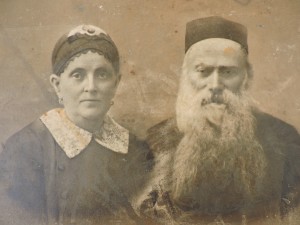Jewish Genealogy: The Journey to Oneself
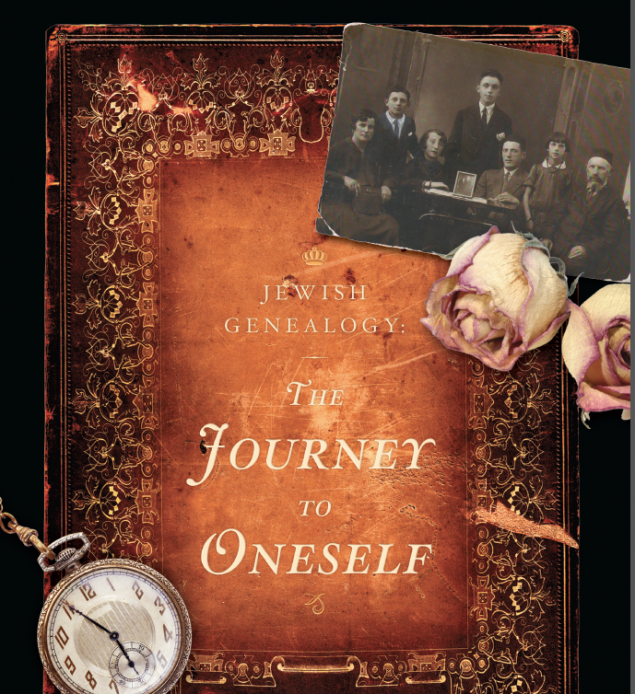
Michoel Jakubowicz, the author’s father, photographed at his bar mitzvah in Sieradz, Poland, 1930. From left to right: The bar mitzvah boy’s mother, Bayla Sheva (nee Kochman), for whom the author is named; the bar mitzvah boy; sister Chaya Sarah; brother David Leibish (standing); Chaya Sarah’s husband Gabriel Henechowicz; younger sister Ita Miriam and father, Hersh (Hersz) Yosef. Everyone except Michoel and David was murdered by the Nazis.
My mother’s death brought to life a disturbing realization.
Although she will always be the precious woman I call “Mommy,” I never really knew her.
During shivah, I spoke about how she survived the Lodz Ghetto, Auschwitz and a death march, broken and alone. But I lacked a sense of who my mother was as a person—her dreams, her hopes, what her family was like (her father, mother, sisters), the color of her life before the black, unspeakable horror. I carried the same longing about my father, also a survivor, who passed away eight years earlier.
With parents who spoke little about their painful pasts, I had a skeletal knowledge of my ancestry. I had resigned myself to a constant undercurrent of disconnection.
Until recently.
In the deafening quiet that followed shivah, I felt a growing hunger to connect to my parents and to their families. I contacted anyone who had known my parents prior to and after the Holocaust, dredging up long-forgotten names. I searched the Israeli online directory and phoned anyone who had the same last names as my parents, asking if we are related. After several attempts, I found Cousin Judy.
In 1937, my father’s uncle fled Europe with his wife and seven daughters; the eldest had an infant, named Judy. My excited phone call to Judy led to many other finds. I entered a wondrous new world of names and faces. I’ve called, e-mailed and Skyped cousins I never knew existed a short month ago, identifying faces in shared photos, traveling back and forth through generations. I felt my world expand. The whirlwind continues.
I’ve joined the growing population of those hooked on genealogy.
Most genealogy addicts start out curious about their family history. As they find the missing pieces to their ancestry puzzle, the hobby turns into an obsession. With the plethora of genealogy web sites offering data going back hundreds of years, and the availability of DNA testing kits, family researchers can conduct their detective work without having to leave the house.
But what’s really pulling them back in time? According to Eviatar Zerubavel, professor of sociology at Rutgers University and author of Ancestors and Relatives: Genealogy, Identity, and Community, individuals who are busy reconstructing their family’s past are not merely keeping track of their ancestral history; they’re refining their identity.
Coming Home to the Past
Arthur Kurzweil, an original member of the International Association of Jewish Genealogical Societies (IAJGS), and author of From Generation to Generation: How to Trace Your Jewish Genealogy and Family History (first published in 1980), concurs. “I didn’t only want to know my ancestors’ names; I wanted to know who they were,” says Kurzweil, who began his search in 1971. He not only discovered hundreds of relatives, he found his place in Yiddishkeit.
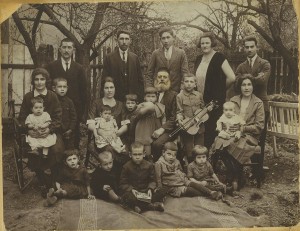
The Kurzweil family in Dobromil, Poland (ca. 1925). Fourteen out of the twenty-one people in the photo were murdered during the Holocaust. Arthur Kurzweil’s great-grandfather, Avraham Abisch Kurzweil, is in the center; Arthur’s father, Chaim Shaul (Saul) Kurzweil is sitting on the ground, second from right.
Photo courtesy of Arthur Kurzweil
Like much of the youth in the late sixties, Kurzweil aligned himself with the “counterculture,” the Beatles and Eastern religions. At one point, Theodore Bikel, a popular Jewish folk singer of that era, visited Kurzweil’s college campus, and surprised his audience when he urged the college students to look into their Judaism.
Kurzweil took him up on it. He knew there had to be more to his heritage than what he had learned in Hebrew school. “I wanted to learn why my ancestors died for this,” he says.
For the first time in his life, he entered the Dorot Jewish Division of the New York City Public Library. He combed the card catalogue for Dobromil, the Polish shtetl where his father was raised, about which he had heard dozens of captivating stories growing up. His initial search brought up genealogical gold in the form of a Memorial Book of Dobromil. (Memorial books or Yizkor books recollect Jewish communities from Eastern Europe, and were typically created after the Holocaust by societies of immigrants from the same town. They often include maps, photographs, narratives and lists of Holocaust victims.) Kurzweil’s doubts about finding a face he would recognize while perusing the book shattered as he sat stunned, staring at a group shot of Dobromil businessmen taken in 1925. In the second row from the bottom, fifth from the left, sat his great-grandfather, Avraham Abisch; the ancestor he had been named for stared back at him.
“I looked at his eyes and saw mine,” says Kurzweil. “‘You have a past,’ [the photo] said, ‘a past and a history, and you can discover it if you want.’ The discovery opened up the door to a search that has taken me many years and that, I am happy to say, offers no end in sight,” he says.
“. . . the entire experience of Jewish history is, in essence, an overview of family history. This is as personal as it gets.”
He contacted every family member he knew; he made phone calls, wrote letters, paid visits—all the while asking questions, gathering information. He sent out questionnaires with return envelopes. He scoured phone directories as well as census and immigration records. After seven years of grueling detective work, he had built a substantial family tree including great-great-great-grandparents with close to 500 of their descendants.
Kurzweil found himself steadily drawn into the world of his ancestors. He began dreaming about them. “I felt as if I was living in a different place and time,” he says. Newspapers interested him less than the historical accounts of Galicia. He collected old photographs of his ancestors in the shtetl, making their experiences his own. Behind many of the people posing in photographs, there were shelves of books. When he learned that these books were the Talmud, the central text of the Jewish people, it struck a deep chord. The feeling only intensified while researching his mother’s family history. A childhood memory relayed by his mother’s Slovakian cousin forever transformed how Kurzweil would see himself. The cousin told him, “Every time I didn’t behave, the adults would yell, ‘This is no way for the einekel of the Stropkover Rebbe to act!’” Kurzweil asked him who this rebbe was. The cousin didn’t know. “I only know they said it every time.”
He discovered that the rebbe, Rabbi Chaim Yosef Gottlieb of Stropkov, born in 1794, was his mother’s great-great-grandfather, and a descendant of the Shelah HaKadosh (Rabbi Yeshaya Horowitz), the revered sixteenth-century scholar of kabbalah.
“Here’s an assimilated kid, growing up in East Meadow, New York, going to public schools and knowing more about Buddha than the Torah,” says Kurzweil. “I didn’t know it when I began my research, but . . . my search for information about my family history was really, at its core, a yearning for Jewish identity.”
For ba’alei teshuvah like myself, the search for one’s ancestors offers a gratifying sense of connection and validation that we can’t experience with our living relatives who are secular. Learning about the challenges of assimilation in our families’ pasts also drives home how our return to Torah impacts Jewish history and the Jewish future.
Salvaging Lost Links
Jeanie Silver’s genealogical pursuit began in the late 1980s. Upon returning to the States after two years of study at Neve Yerushalayim, a women’s kiruv institution for Jewish studies in Jerusalem, Silver, who lives in Brooklyn, New York, received a photo from her cousin. The photo, which the cousin obtained after attending a family reunion, featured a very religious-looking couple: her great-great-grandparents. It spurred Silver to start investigating where she came from.
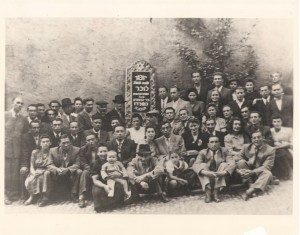
Sieradz survivors in a DP camp in Landsberg, Germany, circa 1946-47. Note the memorial plaque in the background dedicated to those murdered in the Polish town of Sieradz. Seated second row, fourth from the left, is the author’s uncle, David Leibish Jakubowicz; his younger brother Michoel, the author’s father, is seated, same row, second from the right. Next to Michoel, third from the right, is his wife, Mala (Malka), the author’s mother.
Photos courtesy of Bayla Sheva Brenner, unless indicated otherwise.
Silver familiarized herself with public archives and records, finding clues to her great-grandparents’ countries of residence via their American descendants’ death and draft board records. “There was something very comforting to me in connecting to my roots,” says Silver. “I found little bits and pieces that led me to people in the family I never knew. I don’t have a big close family; they became my family. For me, every little bit [of family] I discover is like a gem.”
At the next family reunion in 1997 at a hotel in Skokie, Illinois, Silver asked relative after relative if he or she knew where her great-grandparents were buried. Her cousin Jack handed her a piece of paper; it included the name of the cemetery, the words “Shavel-Yanover” and her great-grandfather’s grave number. She shared her find with the Orthodox rabbi with whom she spent that Shabbat, who told her that Shavel and Yanover are names of Lithuanian towns. He offered to take her to the cemetery the following day.
The next day, she stood before her great-grandfather’s gravestone in the Shavel-Yanover section of the cemetery and recited Tehillim. The rabbi recited Keil Malei Rachamim. “It was captivating,” she says. “We felt like we had a foot in another world.”
As with my search, Michael Salzbank’s interest in mining his family’s history began while sitting shivah for his mother. His journey to the past gleaned valuable life lessons from an ancestor he barely knew.
Rummaging through old files and papers in his parents’ attic, Salzbank, from Queens, New York, unearthed a treasure trove of genealogical information left behind by his maternal grandfather, Joseph Freiman. Two suitcases, untouched for thirty-six years, held piles of old letters, invitations, mailing lists, newspaper clippings and a handwritten timeline of Freiman’s life, beginning with his birth in 1886. “He clearly wrote and saved all of this for this moment in time,” says Salzbank, “when a descendant would come and want to learn about his ancestry.”
Salzbank found a letter dated 1919 that his grandfather had written to his relatives shortly after he arrived in the US from Russia, strongly urging them to keep in close touch with cousins and to help one another. He sifted through self-published newsletters from the 1940s, about and for the family. From yellowed newspaper clippings he read about his grandfather’s fight to help his son who had contracted polio. His grandfather gave up his profession in order to learn physiotherapy and opened up clinics to help others affected by the disease.
Salzbank’s grandfather not only saved every letter he received, he also carbon-copied those he sent out. Names of aunts and uncles, dates of family yahrtzeits and locations of burial sites were written on scrap paper. The information-laden suitcase started him on his journey to creating a family tree that has grown to 2,800 names, with third cousins across the globe. He’s fulfilling his grandfather’s wish to keep in close touch with family, even if it means keeping them alive in memory.
A Father’s Plea
I’m venturing into the lives of the family I never knew; with each photo and story told, I can feel them enter my own life. I’ve come to appreciate my ancestors’ daily struggles with poverty, anti-Semitism and the lure of assimilation. I find myself longing to let each of them know how deeply I care.
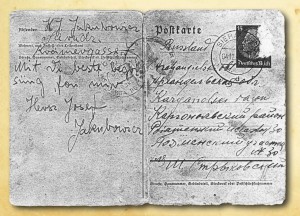
Postcard sent from Hersh (Hersz) Yosef Jakubowicz while searching for his son Michoel (Mulush), the author’s father.
My sisters and I have begun emptying out our parents’ home. I’ve requested to keep an old postcard that my father had held onto until his death. It was written by his father sometime in the early 1940s in the midst of rising Nazi terror when he had lost contact with his son, my father, then twenty-three. At the urging of his parents, my father fled east from the Polish town of Sieradz, away from the approaching German troops. Unfortunately, my father was captured. The night before the Germans planned to execute him, he scaled a wall and ran toward Soviet-occupied Poland. The Russians arrested him and sent him to a Siberian labor camp.
My grandfather’s postcard was a desperate plea to help find his son. Not long after sending it to an acquaintance, my grandfather, along with most of the Jews of Sieradz, was murdered by the Nazis. I asked one of my recently discovered cousins to translate my zaide’s German words on the postcard. He e-mailed the following:
Dear Strykowski,
I beg you to make inquiries concerning my son Mulush Jakubowicz as to where he is, because we don’t know what to think. We are going around like ??? from worry. I beg you ???? and when you find him tell him to write to me. I ask you again to employ all possible means because it is weighing on us very much as we have had no mail from him for the last six months. When it is possible, write to me his [address??] as we live not far away.
With best regards,
Hersz Josef Jakubowicz
Kramergasse (??) #7
Sieradz
My heart broke for my zaide; I wish I could have comforted him. Perhaps, all these years later, I am. I am keeping the Torah that he held onto so tightly, that he hoped would continue.
Uncovering Family
Faces of past relatives lay before me on my desk. I stare at the photo of my great-great-bubby, the mother of my father’s mother, Bayla Sheva (my namesake). It’s the first time I’ve ever seen her face. My eyes meet hers, so penetrating and kind. Somewhere along the family line, sons and daughters cast off Yiddishkeit. I can no longer ask them why. I wonder if my alte bubby knows I’ve made my way back to her and to the life she cherished.
“I didn’t know it when I began my research, but . . . my search for information about my family history was really, at its core, a yearning for Jewish identity.”
The gemara in Masechet Berachot states that the departed are aware of what happens in this world, especially our good deeds, my newfound second cousin in Yerushalayim, a fellow ba’al teshuvah, tells me.
I’m sure my ancestors are pleased. I’m now speaking regularly to their great- and great-great eineklach (grandchildren) in America, England and Eretz Yisrael, and I hear there may be some in Wales and Berlin too! We got to wish each other, via phone, e-mail or Skype, a “shanah tovah” for the first time in our lives.
It’s hard to describe the excitement one feels when uncovering family. Salzbank likens sharing one’s findings with friends to showing family movies—“it’s of limited interest to others.” Silver posits that there are two kinds of people in the world: “those who love genealogy and those who could care less.” Kurzweil says that although over the years his children humored his obsession, they’ve also learned to respect and appreciate his search. “If a teacher mentioned the Shelah HaKadosh, they would say, ‘Abba, guess who[m] we talked about today?’ They feel a connection and great pride.”
From Microfilm to Mainframe
Before the advent of high technology and the mass databasing of public records, tracing one’s ancestry took a lot more time, footwork and perseverance.
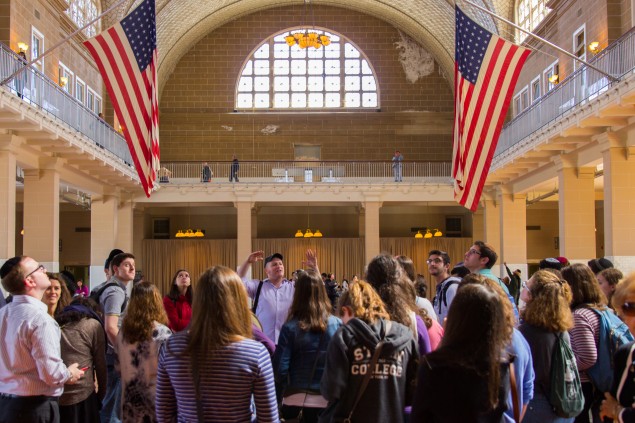
Experienced tour guide and Yeshiva University Alumnus Yitzchak Schwartz walks students through the footsteps of their grandparents in the inspection halls of Ellis Island as part of YU’s Family Discovery Club’s first event. The Family Discovery Club is a club for students at YU interested in researching their personal family histories. Photo: David Kabinsky/Yeshiva University
Gary Mokotoff, one of Jewish genealogy’s pioneers, says the Internet has revolutionized how one goes about conducting family research. “What used to take a trip to Bayonne, New Jersey, to a branch of the National Archives, spending half a day cranking microfilm, is now available in minutes on your computer.” In 1995, Mokotoff, publisher of Avotaynu, the International Review of Jewish Genealogy, and author of an array of books and guides on the subject, took advantage of online databases to research his mother’s side of the family. He now has over 1,750 relatives on his family tree.
Currently, thousands are accessing family histories on Internet databases every day. One of the most popular of these databases is JewishGen, a nonprofit organization affiliated with the Museum of Jewish Heritage—A Living Memorial to the Holocaust in New York. Starting out in 1987 as an online bulletin board, a place for people to network and share their research findings, JewishGen has grown to more than 700 volunteers throughout the world who actively contribute to its growing number of databases, resources and search tools. At this point, JewishGen boasts more than 20 million records and provides a myriad of resources and tools to assist those researching their Jewish ancestry.
Unlike other such sites, JewishGen offers its services free of charge, stating that its mission is solely to encourage the preservation of Jewish heritage. “There’s a huge interest in what we do,” says Avraham Groll, director of business operations for JewishGen. “For some, it’s a hobby; for some, it is a hobby that has turned into something more meaningful. For others, it’s a way of preserving the memory of those killed. We believe this is something people should be able to access.”
Thanks to the Web, the obsession has gone global, as individuals on several continents research their roots together, exchanging information about towns and surnames online.
Some join JewishGen’s Special Interest Groups (SIG), designated by region or culture. The Jewish Genealogical Society, Inc. (JGS), founded in New York in 1977, has grown to over eighty societies worldwide. Many devotees get to meet face-to-face at the Annual International Conference on Jewish Geneology, coordinated by the International Association of Jewish Genealogical Societies (IAJGS), an umbrella organization launched in the 1980s. People have traveled to Paris, London and Jerusalem to attend. The thirty-fourth conference, held this past July in Salt Lake City, featured over a hundred concurrent lectures and welcomed close to 1,400 participants. “You could hold it in Anchorage, Alaska, and get people to come,” says Mokotoff, who has been to all but two throughout his long genealogical career.
Some are actually turning genealogy into a profession. Sarina Roffe is a member of Brooklyn’s Syrian Jewish community and the owner of Sephardic Genealogical Journeys, which specializes in helping members of her community research their family history. Currently working on a book about Rabbi Jacob S. Kassin, chief rabbi of the Syrian Sephardic community in Brooklyn, Roffe was able to trace his ancestry back twenty generations to before the Spanish Inquisition.
“It’s like putting together a puzzle. You try to put all the pieces back to form a complete picture,” says Roffe, who is on the board of JewishGen, has spoken at Jewish genealogical conferences and writes extensively on Sephardic lineage. “People say to me, including my own family, ‘[Why] are you bothering with this, what do you need it for?’ But, as years pass, everyone thanks me for it. We go to a shivah [house] and the first thing they do is ask, ‘When was this person born? When was that person born?’ I just pull out the family tree and all the information is there. Knowing where you come from is one of the most important things.”
The New Generation
Apparently, you’re never too young to start looking back. This past year, Yeshiva University welcomed the Family Discovery Club, a group of youthful, enthusiastic Jewish genealogists. Binyamin Lewis, twenty-two, of Woodmere, New York, founder and president of the club, began his family search at twelve, upon a dare.
When questioning the validity of his grandfather’s assertion that they were descendants of Rabbi Levi Yitzchok of Berditchev, a revered Chassidic leader in eighteenth- and nineteenth-century Poland, his zaide responded, “Okay, big shot, why don’t you go find the proof?” Lewis was off and running.
He used online databases, exchanged e-mails with others researching the same family names and towns and read Arthur Kurzweil’s book on genealogy four times. After many personal discoveries, including research that “strongly suggests a family connection to the Berditchever Rebbe,” he found a cousin who traced his family back to the 1700s in Latvia. Ten years later, he’s still smitten with genealogical research and wants to share the excitement.
“I realized that the entire experience of Jewish history is, in essence, an overview of family history. This is as personal as it gets,” says Lewis, who launched the club with Moshe Wasserman, whom Lewis calls, “the only other person at YU who is just as obsessed with Jewish family history as I am.” Thus far, the YU club, which includes students from Stern College for Women, has held well-attended events geared to teach students how to research one’s family history. The group visited Ellis Island and initiated a “Preserve a Shul Day” on the Lower East Side, where members photographed memorial plaques in the long-standing shuls for JewishGen.org to transcribe and feature as a search option.
“You have to know who your family is,” says Lewis, who is still very active in his own search. “Students see people denying the Holocaust and wondering about the role of Israel in the world. They’re realizing that they don’t really know about their Jewish past.”
When speaking to YU’s Family Discovery Club at its inaugural event this past March, Rabbi Moshe Tzvi Weinberg, mashgiach ruchani in Yeshiva University’s Irving I. Stone Beit Midrash Program (SBMP), emphasized that knowing where one comes from is actually a mitzvah in the Torah. In Parashat Ha’azinu, the Torah tells us, “Zechor yemot olam binu shenot dor va’dor, she’al avicha v’yagedcha, zekeinechah v’yomru lach, Remember the days of yore, understand the years of generation after generation. Ask your father and he will relate it to you, and your elders and they will tell you” (32:7).
The Ramban on Parashat Va’etchanan says our link to Hashem Himself is through the awe-inspiring chain that goes back to Har Sinai. As long as we preserve that chain and understand our place in it, it is a direct link to God Himself.
As my mother reunites with the family she missed for a lifetime, I’m continuing to learn about the lives that led to mine. I’ve reclaimed bubbies, zaides, aunts, uncles and cousins. I feel them rooting for me; I’ve restored the broken link to Torah. I too am grateful—my newly discovered ancestors have given me a spiritual anchor.
I miss you, Mom.
Bayla Sheva Brenner is senior writer in the OU Communications and Marketing Department.

